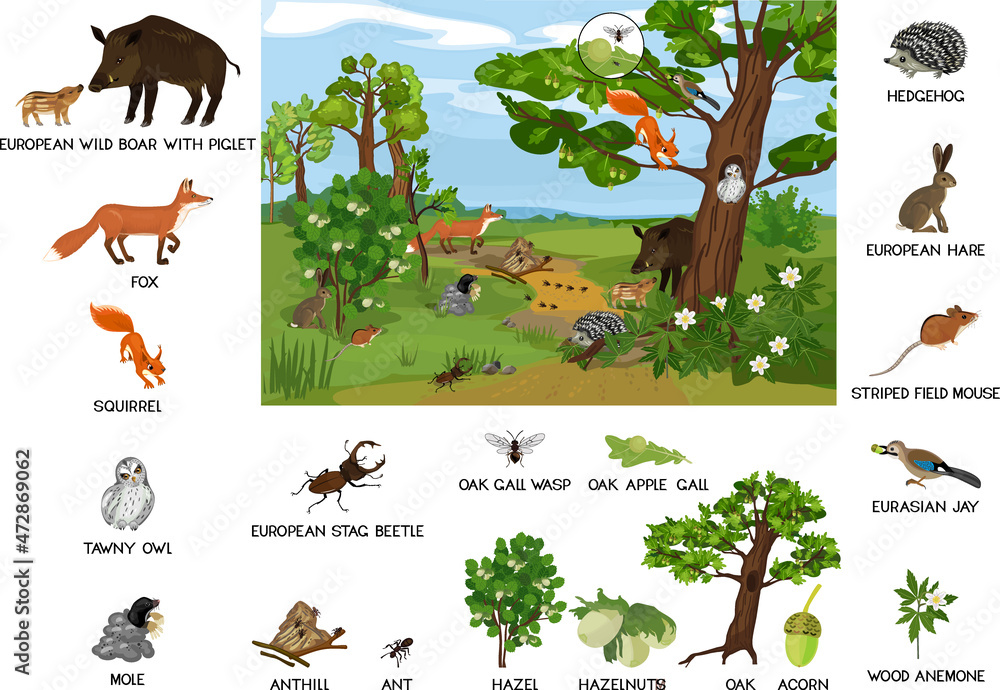Topic ecosystem services of forests: Discover the invaluable ecosystem services of forests, vital for our planet"s health and our well-being, highlighting the multifaceted benefits they provide to humanity and the environment.
Table of Content
- What are the ecosystem services provided by forests?
- Overview of Ecosystem Services
- Provisioning Services
- Regulating Services
- Cultural Services
- Supporting Services
- YOUTUBE: Forest Ecosystem Services Management
- Climate Change Mitigation
- Biodiversity and Habitat Support
- Water Regulation and Purification
- Soil Formation and Erosion Control
- Recreational and Aesthetic Values
- Carbon Sequestration and Storage
What are the ecosystem services provided by forests?
The ecosystem services provided by forests include:
- Carbon storage: Forests capture and store carbon dioxide, helping to mitigate climate change.
- Air purification: Trees absorb pollutants and release oxygen, improving air quality.
- Water regulation: Forests regulate water flow, reducing the risk of flooding and maintaining water quality.
- Soil protection: Tree roots hold soil in place, preventing erosion and maintaining soil fertility.
- Biodiversity support: Forests provide habitat for a wide range of plant and animal species, supporting biodiversity.
- Timber and non-timber products: Forests are a source of timber, as well as various non-timber products like fruits, nuts, and medicinal plants.
- Recreation and tourism: Forests offer opportunities for outdoor activities, such as hiking, camping, and wildlife watching.
- Cultural and spiritual values: Forests hold cultural significance and provide spiritual nourishment for many communities.
These services are essential for maintaining ecological balance, supporting human well-being, and sustaining a healthy planet.
READ MORE:
Overview of Ecosystem Services
Ecosystem services provided by forests are indispensable to human wellbeing and the health of our planet. These services encompass a wide range of benefits that forests offer to humanity, including both tangible and intangible values. Forests play a crucial role in supporting life by maintaining biodiversity, regulating climates, and contributing to the mental and physical health of individuals.
- Provisioning Services: Forests are a source of essential goods such as timber, food, fuel, and medicinal plants, providing the raw materials necessary for our survival and economic activities.
- Regulating Services: They contribute to climate regulation, water purification, and disease control, mitigating natural disasters and ensuring environmental stability.
- Cultural Services: Forests hold cultural, spiritual, and recreational values, offering spaces for tourism, education, and spiritual reflection.
- Supporting Services: Critical for ecosystem health, these services include soil formation, nutrient cycling, and providing habitats for diverse species, ensuring biodiversity and ecological productivity.
Moreover, forests play a pivotal role in climate change mitigation through carbon sequestration, capturing and storing carbon dioxide to reduce the concentration of greenhouse gases in the atmosphere. This function not only combats global warming but also supports a stable climate conducive to sustainable development and human prosperity.
Conservation and sustainable management of forests are thus vital for maintaining these ecosystem services, ensuring that they continue to benefit present and future generations. Through responsible stewardship of forest resources, we can safeguard these invaluable services and support the resilience of our global ecosystem.

Provisioning Services
Forests are vital for their provisioning services, supplying a plethora of resources essential for human survival and economic prosperity. These resources range from basic necessities such as food and water to raw materials for construction and pharmaceuticals. The provisioning services of forests not only contribute significantly to the livelihoods of millions of people worldwide but also underpin many industries and economic activities.
- Food: Forests provide a variety of foods including fruits, nuts, mushrooms, and honey, which are crucial for the nutrition and food security of local communities and indigenous peoples.
- Raw Materials: Timber for construction and furniture, fibers for clothing, and biomass for energy production are all sourced from forests, playing a key role in various sectors of the economy.
- Medicinal Resources: Many pharmaceuticals are derived from plant species found in forests. These natural medicines are vital for healthcare systems around the world, offering treatments for diseases and ailments.
- Freshwater: Forested catchments are essential for the purification and supply of freshwater, supporting agriculture, drinking, and sanitation needs.
The sustainable management of forest resources is crucial to ensure that these provisioning services continue to support current and future human needs. Overexploitation, deforestation, and environmental degradation pose significant threats to the availability of these resources. Therefore, balancing the extraction of forest products with conservation efforts is essential for the long-term sustainability of forests" provisioning services.
Regulating Services
Forests play a critical role in the regulation of Earth"s environment, providing services that maintain the balance of natural systems and ensure their resilience. These regulating services are essential for mitigating environmental challenges, such as climate change and pollution, and for supporting the stability and health of the planet"s ecosystems. By influencing climate, water, and air quality, forests contribute significantly to the well-being of all living organisms.
- Climate Regulation: Through the process of photosynthesis, forests absorb carbon dioxide from the atmosphere, helping to reduce greenhouse gas concentrations and mitigate climate change. Additionally, the presence of forests influences local and global climates by affecting temperature and precipitation patterns.
- Water Regulation and Purification: Forests regulate the water cycle by capturing rainwater, replenishing groundwater supplies, and reducing the risk of floods and droughts. They also filter pollutants from water, ensuring the quality of freshwater resources.
- Air Quality Improvement: Trees absorb pollutants such as sulfur dioxide and nitrogen oxides, improving air quality and providing cleaner air for humans and wildlife.
- Soil Erosion Control: Forests prevent soil erosion by stabilizing the soil with their root systems, reducing the impact of heavy rains and preventing landslides and sedimentation in rivers and lakes.
- Pollination and Seed Dispersal: Forest ecosystems support the survival of many plant and animal species by facilitating pollination and seed dispersal, which are crucial for biodiversity and the reproduction of forest plants.
The preservation and sustainable management of forests are therefore imperative for maintaining these regulating services. Actions aimed at protecting forests, restoring degraded lands, and implementing sustainable forestry practices are essential to ensure that forests continue to provide these vital services to the planet and its inhabitants.
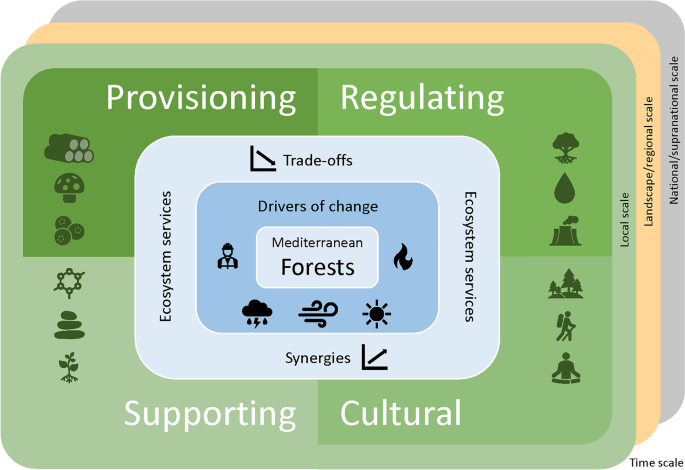
Cultural Services
Forests are not only crucial for their ecological and economic benefits but also for the cultural services they provide. These services are deeply intertwined with human societies, offering spiritual enrichment, cognitive development, recreation, and aesthetic experiences. Forests have been the backdrop for cultural practices, traditions, and folklore for centuries, reflecting the profound connection between humans and nature.
- Spiritual and Religious Significance: Many cultures and religions revere forests as sacred spaces, sites for spiritual practices, and sources of inspiration. They are integral to the identity and spirituality of countless communities around the world.
- Recreational Opportunities: Forests provide spaces for outdoor activities such as hiking, bird watching, and camping, contributing to physical health and well-being. These recreational experiences foster a connection with nature and promote mental health.
- Educational Resources: As living laboratories, forests offer invaluable opportunities for environmental education and research, enhancing our understanding of ecosystems, conservation, and sustainable practices.
- Aesthetic Inspiration: The intrinsic beauty of forests has inspired artists, writers, and musicians, influencing countless works of art, literature, and music. This aesthetic value enriches human culture and creativity.
- Heritage and Identity: Forests are an integral part of the cultural heritage and identity of many communities, preserving traditional knowledge, customs, and languages related to forest ecosystems and their management.
The conservation of forests is vital not only for their physical benefits but also for protecting these cultural values. Preserving forested landscapes and their biodiversity ensures that future generations can continue to enjoy and learn from these natural and cultural treasures. Through sustainable management and conservation efforts, we can safeguard the cultural services forests provide, further strengthening the bond between humanity and the natural world.
Supporting Services
Supporting services are fundamental ecological processes that are necessary for the production of all other ecosystem services. These services enable the functioning of ecosystems, supporting their capacity to provide provisioning, regulating, and cultural services. Forests, with their complex ecological structures, play a crucial role in offering these underlying services, which are essential for ecosystem health, resilience, and productivity.
- Photosynthesis: The process by which forests convert sunlight into energy, producing oxygen and sequestering carbon dioxide, is foundational for life on Earth. This process supports not only the forest"s own growth and development but also the atmospheric balance critical for all living organisms.
- Nutrient Cycling: Forest ecosystems are efficient at recycling nutrients, decomposing organic matter, and facilitating the transfer of nutrients from the soil to plants. This nutrient cycling is essential for soil fertility and the overall productivity of the forest.
- Soil Formation: Through the decomposition of organic matter, forests contribute to the formation of soil, a critical component for plant growth. This process also helps in the accumulation of organic matter, enhancing soil structure and fertility.
- Habitat Provision: Forests provide habitats for millions of species, including many that are endemic or threatened. This biodiversity is crucial for ecosystem stability, evolutionary processes, and the provision of many other ecosystem services.
- Water Cycle Regulation: By influencing precipitation patterns and water filtration, forests play a vital role in the global and local water cycles. They help in maintaining the availability of freshwater resources, crucial for all forms of life.
The maintenance of these supporting services is essential for the sustainability of ecosystems and the myriad benefits they provide to humans. Recognizing the value of these services underscores the importance of conserving and sustainably managing forests to ensure the health and resilience of ecosystems worldwide. Through such efforts, we can ensure the continued provision of vital ecosystem services for future generations.

Forest Ecosystem Services Management
\"Discover the secrets of effective management in our insightful video. Learn practical strategies and techniques to enhance your leadership skills and create a harmonious work environment. Watch now and unlock your potential as a successful manager!\"
Climate Change Mitigation
Forests play a pivotal role in mitigating climate change, one of the most pressing challenges facing humanity today. Through natural processes such as photosynthesis, forests absorb carbon dioxide from the atmosphere, storing carbon in trees, soil, and vegetation. This carbon sequestration process is a key component in reducing the overall concentration of greenhouse gases in the atmosphere, thereby contributing to the regulation of the Earth"s climate. The role of forests in climate change mitigation encompasses several crucial aspects:
- Carbon Sequestration: Forests act as carbon sinks, capturing carbon dioxide from the atmosphere and converting it into biomass. This process reduces the amount of greenhouse gases, helping to stabilize global temperatures.
- Carbon Storage: The vast amounts of carbon stored in forest biomass, soil, and dead organic matter make forests critical in the global carbon cycle. Protecting existing forests and preventing deforestation are essential strategies in maintaining and enhancing forest carbon storage capacities.
- Reducing Emissions from Deforestation and Forest Degradation (REDD+): Initiatives aimed at reducing emissions from deforestation and forest degradation are crucial in climate change mitigation efforts. By incentivizing the protection and sustainable management of forests, REDD+ programs contribute to the reduction of carbon emissions and support the conservation of forest biodiversity.
- Renewable Energy Sources: Forests provide biomass for renewable energy production, offering an alternative to fossil fuels. The sustainable management of forest resources for energy purposes can significantly reduce carbon footprints and combat climate change.
The integration of forest conservation into global climate change strategies is vital for achieving emissions reduction targets and ensuring a sustainable future. Supporting afforestation, reforestation, and sustainable forestry practices are key measures in leveraging the climate mitigation potential of forests. By doing so, we not only combat climate change but also enhance biodiversity, improve air and water quality, and secure livelihoods for communities dependent on forest resources.
Sustaining Forest Ecosystem Services
\"Explore the key principles of sustaining for a better future in our eye-opening video. Uncover sustainable practices and innovative ideas that can positively impact our planet. Join us on this enlightening journey and be inspired to make a difference!\"
Biodiversity and Habitat Support
Forests are critical for the maintenance of global biodiversity, providing a myriad of habitats for plants, animals, and microorganisms. These rich ecosystems support a vast array of life forms, many of which are endemic or rare species, making forests essential for conserving the world"s biological diversity. The support for biodiversity and habitats that forests offer includes several key elements:
- Habitat Diversity: Forests contain a wide range of habitats, from the forest floor to the canopy, supporting diverse life forms. Each layer of the forest provides unique living conditions for different species, contributing to the complexity and richness of forest ecosystems.
- Species Conservation: Forests serve as sanctuaries for countless species, including many that are threatened or endangered. By preserving forested areas, we protect the habitats necessary for the survival and reproduction of these species.
- Genetic Diversity: The wide variety of species found in forests contributes to genetic diversity, which is crucial for resilience to diseases and environmental changes. This diversity also underpins ecosystem services and provides resources for breeding programs and scientific research.
- Ecosystem Stability: Biodiversity contributes to the stability and resilience of ecosystems. Diverse forest ecosystems are better equipped to withstand and recover from environmental stresses, diseases, and climate change impacts.
- Natural Corridors: Forests often act as natural corridors that allow for the migration and dispersal of species, facilitating genetic exchange and adaptation across landscapes. These corridors are crucial for the maintenance of ecological networks and biodiversity conservation.
Conserving forest biodiversity is not only vital for the environment but also for human well-being, providing essential services such as pollination, pest control, and disease regulation. Efforts to protect and restore forest ecosystems, through sustainable management practices and conservation policies, are key to maintaining the earth"s biodiversity and the invaluable services it provides. By valuing and preserving our forests, we ensure a rich natural heritage for future generations.

Water Regulation and Purification
Forests play a critical role in the regulation and purification of water, contributing significantly to the health and sustainability of our planet"s water systems. Through a series of natural processes, forests manage the flow of water within ecosystems, ensuring clean and abundant water supplies for a myriad of uses. Below are key aspects of how forests contribute to water regulation and purification:
- Natural Filtration: As rainwater passes through forest soil, it is naturally filtered. This process removes pollutants and sediments, improving water quality before it reaches rivers, lakes, and aquifers.
- Water Cycle Regulation: Forests play an essential role in the water cycle by capturing rainwater, which then evaporates or transpires through plants back into the atmosphere, contributing to rainfall distribution across regions.
- Streamflow Regulation: By absorbing rainfall, forests reduce the speed and amount of runoff, mitigating flood risks and ensuring a steady supply of water to streams and rivers during dry periods.
- Erosion Control: The root systems of forest trees and undergrowth prevent soil erosion, keeping rivers and lakes clear of sediments that can degrade water quality and harm aquatic ecosystems.
- Groundwater Recharge: Forested areas facilitate the infiltration of water into the ground, replenishing aquifers and groundwater reserves essential for drinking, agriculture, and industry.
- Habitat Protection: Healthy forest ecosystems support diverse aquatic habitats by maintaining clean and stable water bodies, crucial for the survival of countless species.
Moreover, forests act as natural water towers, storing water in their biomass and releasing it slowly over time. This storage and release mechanism is vital for the availability of fresh water during periods of scarcity, highlighting the importance of forests in securing water resources for future generations.
Through these mechanisms, forests are indispensable to water regulation and purification processes, underlining the need for their protection and sustainable management to ensure the continued provision of these essential ecosystem services.
Soil Formation and Erosion Control
Forests are fundamental to the formation of soil and its protection against erosion. Through intricate and sustained processes, forests contribute to the creation of fertile soil while preventing its loss, ensuring the longevity and health of terrestrial ecosystems. The following points elaborate on the multifaceted roles forests play in soil formation and erosion control:
- Contribution to Soil Formation: Forests enhance soil formation through the decomposition of organic matter. Leaves, branches, and dead organisms decompose to form humus, enriching the soil with nutrients essential for plant growth.
- Enhancement of Soil Structure: The presence of organic matter from forests improves soil structure, increasing its porosity and water retention capacity. This makes soils under forests more fertile and better able to support diverse plant life.
- Root Systems Stabilize Soil: The extensive root systems of forest trees anchor the soil, reducing displacement and loss. This root network is crucial in preventing landslides and soil erosion, particularly on slopes and in areas prone to heavy rains.
- Protection Against Water Erosion: Forest canopies intercept rainwater, reducing its impact on the soil surface. This diminishes runoff speed and volume, lowering the risk of soil erosion by water.
- Reduction of Wind Erosion: Forests act as windbreaks, decreasing wind speed and, consequently, the amount of soil eroded by wind. This is especially vital in dry, arid regions where wind erosion can be significant.
- Maintenance of Soil Moisture: By providing shade, forests reduce evaporation from the soil surface, maintaining soil moisture levels. This is essential for the survival of many plant and animal species and for the prevention of desertification.
Forests thus play a critical role in nurturing and protecting soils, which are a foundational component of the Earth"s ecosystems. The preservation and sustainable management of forests are crucial for maintaining soil health, supporting biodiversity, and ensuring ecosystem resilience against the impacts of climate change and human activities.

Recreational and Aesthetic Values
Forests offer immense recreational and aesthetic benefits that contribute significantly to human well-being and quality of life. These natural landscapes provide spaces for leisure, physical activities, and spiritual renewal, while their beauty and tranquility offer psychological benefits by reducing stress and enhancing mood. Below are the key aspects of forests" recreational and aesthetic values:
- Natural Playgrounds: Forests serve as vast natural playgrounds where people can engage in hiking, biking, bird-watching, and camping. These activities not only promote physical health but also provide opportunities for learning and adventure in a natural setting.
- Spaces for Relaxation and Reflection: The serene and majestic beauty of forests offers ideal environments for relaxation and reflection. Many find peace and solace in the quiet of the woods, which acts as a respite from the hustle and bustle of urban life.
- Source of Inspiration: Artists, writers, and creators have long drawn inspiration from the aesthetic beauty of forests. The diversity of landscapes, the play of light through the trees, and the myriad colors and textures provide endless inspiration for creativity.
- Educational Opportunities: Forests are living laboratories where children and adults alike can learn about ecology, biology, and conservation. Educational programs in forests help raise awareness of the importance of preserving these vital ecosystems for future generations.
- Cultural and Historical Significance: Many forests are imbued with cultural and historical significance, hosting sites that are sacred or important to local communities and indigenous peoples. These forests are places of heritage and identity, connecting people to their ancestors and traditions.
- Enhancement of Landscape Beauty: The aesthetic appeal of forests enhances the beauty of landscapes, contributing to the scenic value of a region. This not only improves the quality of life for residents but also attracts tourists, providing economic benefits through eco-tourism.
Through these diverse roles, forests enrich our lives, offering spaces for recreation, sources of beauty, and inspiration. The preservation of forests is thus not only critical for ecological balance but also for maintaining the cultural and recreational spaces that humans cherish.
READ MORE:
Carbon Sequestration and Storage
Forests play a pivotal role in mitigating climate change through carbon sequestration and storage, acting as major carbon sinks. They absorb carbon dioxide (CO2), one of the principal greenhouse gases, from the atmosphere during the process of photosynthesis, converting it into biomass and storing it in trees, undergrowth, and soil. This natural process is crucial for reducing the global concentration of CO2, thereby contributing to climate regulation. Here are the significant ways forests contribute to carbon sequestration and storage:
- Photosynthesis: Trees and plants absorb CO2 from the atmosphere and use sunlight to convert it into organic compounds, releasing oxygen in the process. This fundamental biological process is the cornerstone of carbon sequestration in forests.
- Biomass Storage: The majority of the carbon absorbed by forests is stored in the form of biomass within tree trunks, branches, leaves, and roots. Mature forests, in particular, can store vast amounts of carbon for centuries, making them invaluable in climate change mitigation efforts.
- Soil Carbon Storage: Forest soils are significant carbon stores, with decaying plant material and root systems contributing to soil organic carbon. Proper management and conservation of forests can enhance soil carbon sequestration, further increasing the carbon storage capacity of forests.
- Reduction of Greenhouse Gases: By sequestering and storing carbon, forests help reduce the concentration of CO2 in the atmosphere, directly impacting the reduction of greenhouse gases and mitigating global warming.
- Long-term Carbon Storage: Old-growth forests and peatlands represent long-term carbon storage ecosystems. Conservation of these areas is critical for maintaining and enhancing their role as global carbon sinks.
Effective forest management and conservation strategies are essential to maximize the potential of forests in carbon sequestration and storage. This includes avoiding deforestation, promoting reforestation and afforestation, and implementing sustainable forest management practices. Such efforts not only combat climate change but also preserve biodiversity, support ecosystems, and provide a myriad of other ecosystem services. In essence, forests are a key component in the global response to climate change, highlighting the necessity of their protection and sustainable management.
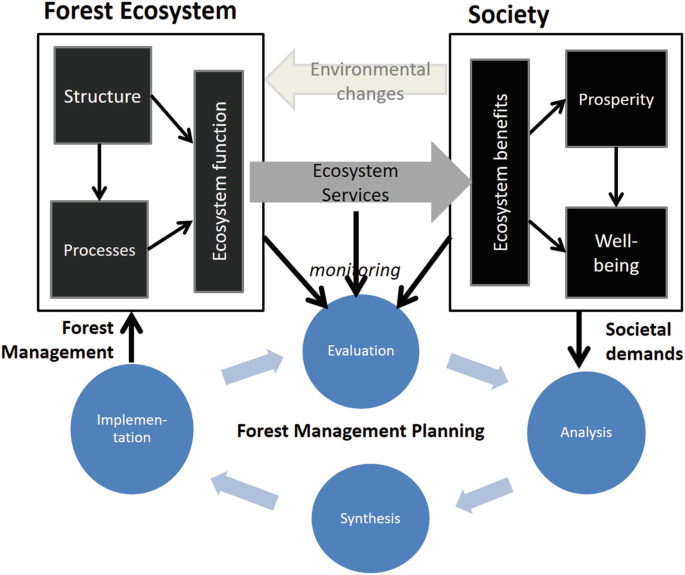
:max_bytes(150000):strip_icc()/497408077-56af61ff3df78cf772c3c309.jpg)

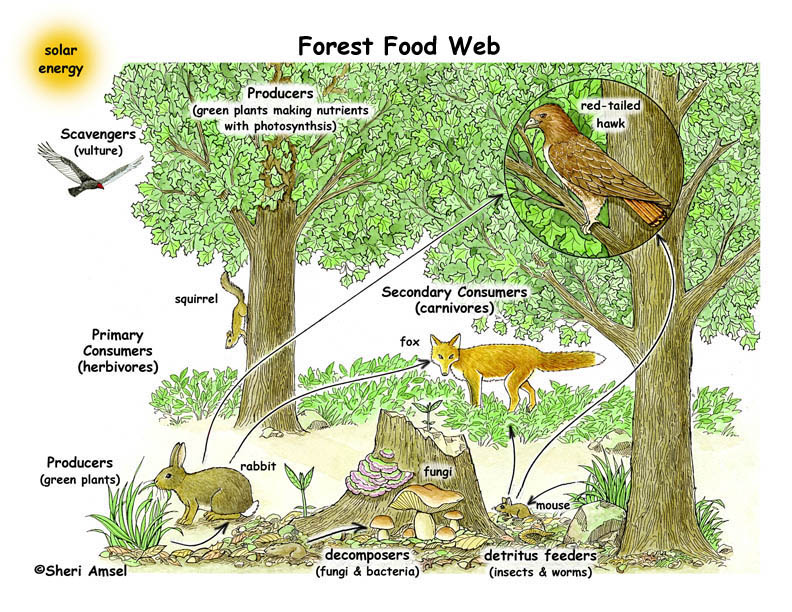


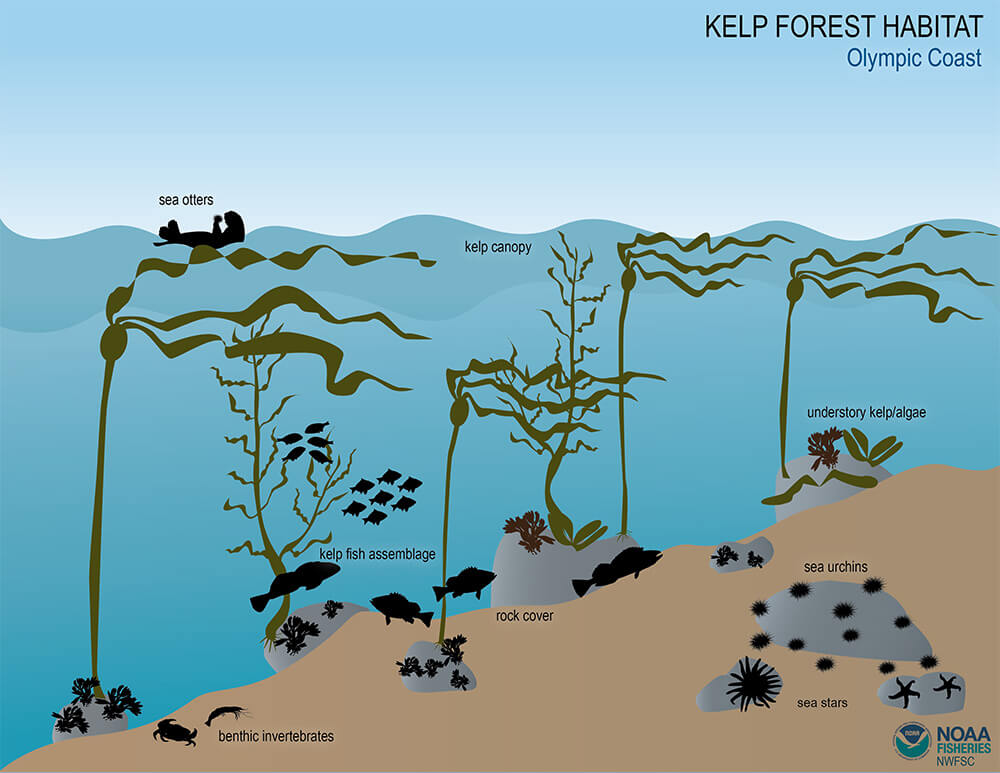



:max_bytes(150000):strip_icc()/489034241_5-56af62885f9b58b7d0183204.jpg)
